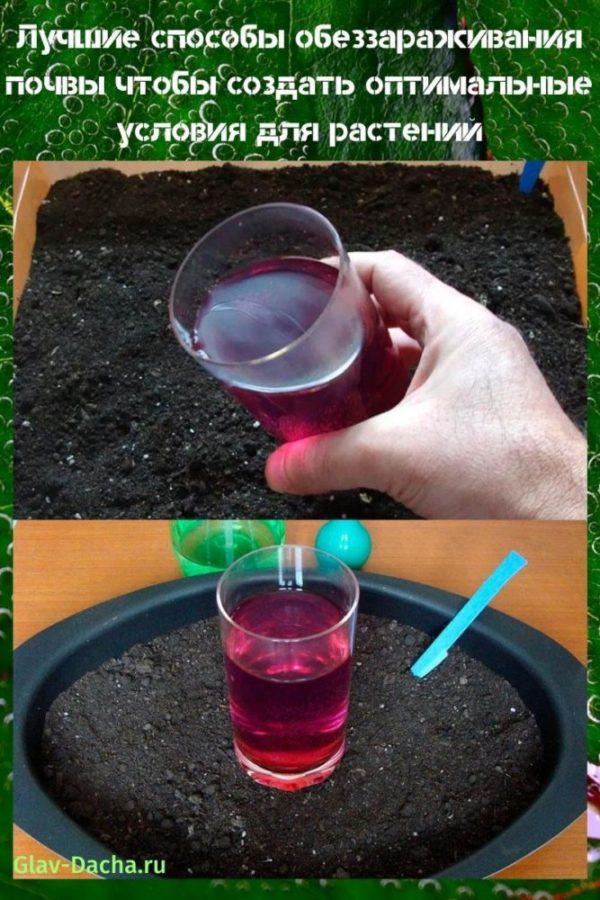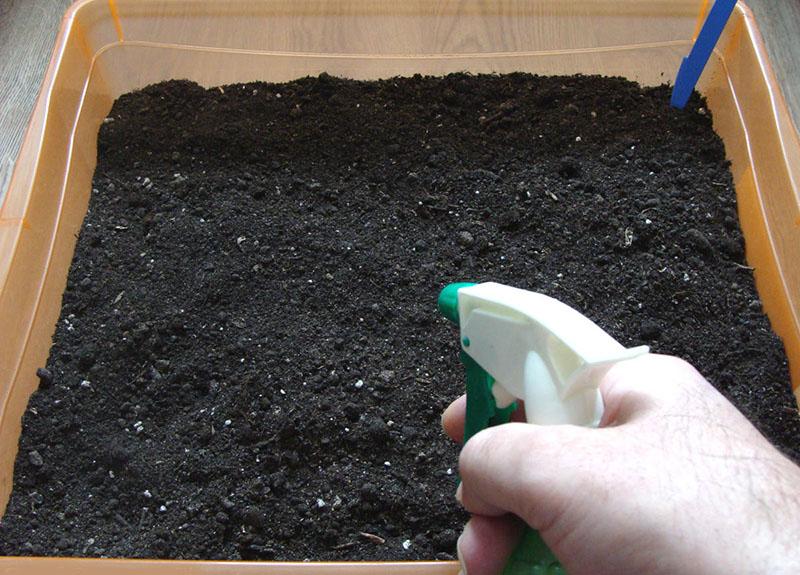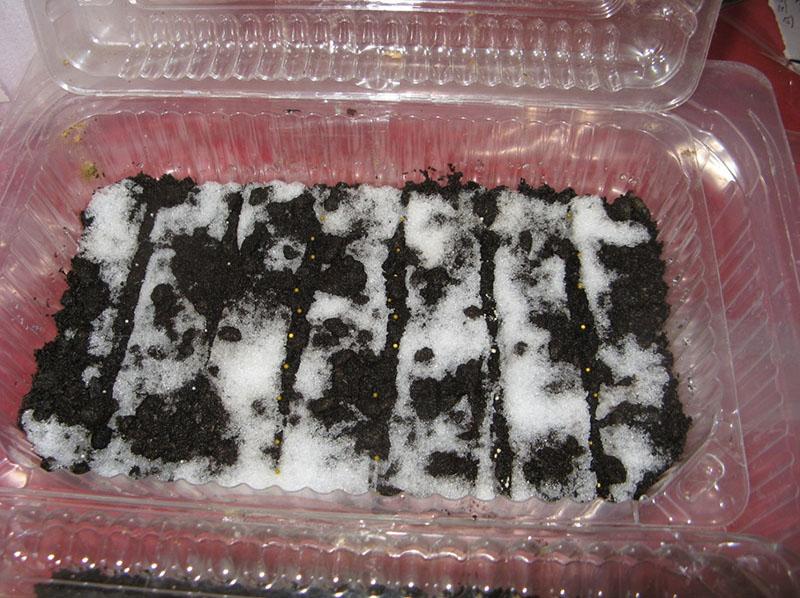The best ways to decontaminate soil to create optimal conditions for plants
 Experienced owners of summer cottages know that any untreated soil is a source of infection for young plants. And so that they do not get sick, preliminary soil disinfection is necessary. After all, a healthy soil saturated with useful substances is the key to obtaining strong, viable seedlings, and obtaining a high yield. Novice gardeners rarely think about the fact that the soil should be disinfected before planting seeds or seedlings in it. This is especially true of purchased land, the packaging of which says that it is completely ready for use, which is fundamentally wrong.
Experienced owners of summer cottages know that any untreated soil is a source of infection for young plants. And so that they do not get sick, preliminary soil disinfection is necessary. After all, a healthy soil saturated with useful substances is the key to obtaining strong, viable seedlings, and obtaining a high yield. Novice gardeners rarely think about the fact that the soil should be disinfected before planting seeds or seedlings in it. This is especially true of purchased land, the packaging of which says that it is completely ready for use, which is fundamentally wrong.
Disinfection of soil for planting seeds and seedlings

Freezing
 If the soil is harvested in autumn, then in winter, when severe frosts come, the bags are taken out into the open air. When the ground is completely frozen and becomes like stone, it is brought back to a warm place for a week. This is done so that the larvae of pests wintering in the soil wake up and weeds start growing. Then the soil is frozen again. This contrasting temperature change is carried out at least 3 times. If the soil has not been prepared since autumn, then a few weeks before the expected planting of seeds or seedlings, it is laid out in a thin layer on pallets and the freezer is placed for a day. Then they are taken out, left warm and again put away for freezing. A couple of procedures are enough.
If the soil is harvested in autumn, then in winter, when severe frosts come, the bags are taken out into the open air. When the ground is completely frozen and becomes like stone, it is brought back to a warm place for a week. This is done so that the larvae of pests wintering in the soil wake up and weeds start growing. Then the soil is frozen again. This contrasting temperature change is carried out at least 3 times. If the soil has not been prepared since autumn, then a few weeks before the expected planting of seeds or seedlings, it is laid out in a thin layer on pallets and the freezer is placed for a day. Then they are taken out, left warm and again put away for freezing. A couple of procedures are enough.
This method has several disadvantages.:
- it is not suitable for soil with biohumus, since, along with pathogenic bacteria, all useful microflora is destroyed in the soil;
- freezing does not kill phytophthora; it can only be affected by calcination.
Steaming
 A gentle way of soil disinfection. The soil is placed in small portions in a colander, on the bottom of which a thin cloth is placed so that earth particles do not fall out through the holes. Boil water in a saucepan and place a colander with soil on top so that the bottom does not touch the surface of the water. Steam the ground for 10 minutes, stirring constantly. In addition to disinfection with this method, the soil is additionally saturated with moisture. The soil is also steamed in a bucket, laying it in a cloth bag on a wire rack. After steam treatment, the soil is left to cool, spreading it out on a baking sheet in a layer of 5 cm to enrich it with oxygen.
A gentle way of soil disinfection. The soil is placed in small portions in a colander, on the bottom of which a thin cloth is placed so that earth particles do not fall out through the holes. Boil water in a saucepan and place a colander with soil on top so that the bottom does not touch the surface of the water. Steam the ground for 10 minutes, stirring constantly. In addition to disinfection with this method, the soil is additionally saturated with moisture. The soil is also steamed in a bucket, laying it in a cloth bag on a wire rack. After steam treatment, the soil is left to cool, spreading it out on a baking sheet in a layer of 5 cm to enrich it with oxygen.
Calcination
 The soil is scattered on pallets in a layer of 5 cm and put into an oven heated to a temperature of 90 degrees. Calcined for half an hour. The temperature should not be raised more than 90 degrees, otherwise mineralization of the soil will occur during overheating. nitrogen, which will reduce the quality of the soil. All microorganisms die during calcination.
The soil is scattered on pallets in a layer of 5 cm and put into an oven heated to a temperature of 90 degrees. Calcined for half an hour. The temperature should not be raised more than 90 degrees, otherwise mineralization of the soil will occur during overheating. nitrogen, which will reduce the quality of the soil. All microorganisms die during calcination.
Every time the soil is disinfected with high temperatures, it needs to be enriched with nutrients. Therefore, a liquid biohumus fertilizer is added to it.
Etching
 Otherwise, the procedure for disinfecting the soil is called spilling. The soil is treated with a slightly pink solution of potassium permanganate.Crystals of gray powder in an amount of 3 g are diluted in 10 liters of water. The disadvantage of treating the soil with potassium permanganate is the pickling of only its upper layer. Also, potassium permanganate does not kill a large number of seedling pathogens.
Otherwise, the procedure for disinfecting the soil is called spilling. The soil is treated with a slightly pink solution of potassium permanganate.Crystals of gray powder in an amount of 3 g are diluted in 10 liters of water. The disadvantage of treating the soil with potassium permanganate is the pickling of only its upper layer. Also, potassium permanganate does not kill a large number of seedling pathogens.
For a more thorough etching, fungicides (antifungal agents) are used. it Fitosporin-M, Zamair, Revival. These preparations contain beneficial bacteria that destroy pathogenic organisms in the soil. But this process is not fast, it takes at least 2 weeks to completely disinfect the soil.
Disinfection with ultra-frequency waves
 Before cultivating the land before planting seeds in the microwave, it is first spilled with a solution of potassium permanganate, then placed in the oven, set to maximum power and set a timer for 3 minutes.
Before cultivating the land before planting seeds in the microwave, it is first spilled with a solution of potassium permanganate, then placed in the oven, set to maximum power and set a timer for 3 minutes.
Immediately after disinfection, the soil becomes sterile. New microflora begins to form in it after 10-15 days. If the soil is not planned to be used immediately, to prevent the appearance of new pathogenic microorganisms in it, immediately after disinfection, the soil is transferred to a sterile bag and removed to a cool place until the moment of planting. Before use, add a liter of vermicompost or a couple of glasses of supercompost to a bucket of soil.
There is always a risk of introducing pathogenic microflora with seeds into sterile soil. Therefore, they are also disinfected before planting.
If, despite all efforts to disinfect seeds and soil, the seedlings still start to hurt, the situation can be corrected. Seedlings are transplanted into new pots with treated soil, diseased plants are removed. If the seedlings are already large, they are prepared for planting in a greenhouse or in open ground in a permanent place. In this case, the plants are watered with diluted ammonia, which will scare away insects. In 10 liters of water, 2 tbsp is diluted. l. 10% ammonia and water each seedling bush with a solution.
Disinfection of open and greenhouse ground
 Every year, fungi, pest larvae, and pathogenic microorganisms accumulate on the beds of summer cottages. For the normal development of seedlings and a good harvest, the best option would be to replace the topsoil from the beds with a new one every year. But how to process the soil for seedlings, if you cannot regularly remove a whole layer of soil and buy a new one. The answer suggests itself - to disinfect it.
Every year, fungi, pest larvae, and pathogenic microorganisms accumulate on the beds of summer cottages. For the normal development of seedlings and a good harvest, the best option would be to replace the topsoil from the beds with a new one every year. But how to process the soil for seedlings, if you cannot regularly remove a whole layer of soil and buy a new one. The answer suggests itself - to disinfect it.
The method of disinfection is chosen depending on the composition of the soil, its acidity, diseases that plants in a particular climatic zone are exposed to.
Etching
 Do this in the fall after harvest and in the spring before planting seedlings. Dissolve a pack of Fitosporin 100 gr. in half a liter of water. A concentrated solution is obtained. It is bred immediately before starting the processing of greenhouse soil. Add 1 tablespoon of the concentrate to 10 liters of water. The resulting product is poured from the garden watering can. The greenhouse is closed for 3 weeks so that the beneficial bacteria from Fitosporin are activated and do their job of disinfecting the soil. After that, seedlings are planted.
Do this in the fall after harvest and in the spring before planting seedlings. Dissolve a pack of Fitosporin 100 gr. in half a liter of water. A concentrated solution is obtained. It is bred immediately before starting the processing of greenhouse soil. Add 1 tablespoon of the concentrate to 10 liters of water. The resulting product is poured from the garden watering can. The greenhouse is closed for 3 weeks so that the beneficial bacteria from Fitosporin are activated and do their job of disinfecting the soil. After that, seedlings are planted.
Disinfection of the soil before planting seedlings is carried out with a pink solution of potassium permanganate, which is abundantly watered in the greenhouse, after which it is closed for several hours. Potassium permanganate is an oxidizing agent, therefore, it is used to disinfect chernozem and soddy-calcareous soils. It is not suitable for acidic soils.
For prevention, the soil is treated with Baikal EM-1. For 10 liters of water, dissolve 150 ml of the product and spill soil at the rate of 2.5 liters. to the square of the earth.
The antibacterial agent Trichodermin is used as biological substances used for soil disinfection. As a biologically active substance, it contains useful fungi that suppress mycobacteria in the soil. 1 g of Trichodermina is required per square meter of soil. It is preliminarily bred in water.
Boiling water or insecticide treatment
 Scalding removes germs, fungi and bacteria from the soil. They put a hose on the beds, cover the soil with a film so that it does not cool as long as possible, let boiling water through the hose.
Scalding removes germs, fungi and bacteria from the soil. They put a hose on the beds, cover the soil with a film so that it does not cool as long as possible, let boiling water through the hose.
Insecticides are drugs used to kill soil pests. The most commonly used funds are Thunder, Aktara, Iskra. Dry insecticides are mixed with soil, which is previously loosened. Then the soil is watered abundantly.
Soil disinfection with insecticides is carried out one and a half months before planting seedlings.
Chemicals
 They are used for soil disinfection only when folk methods and biological substances do not help. Before watering the ground before planting with these aggressive substances, it should be remembered that their improper application can destroy all plants.
They are used for soil disinfection only when folk methods and biological substances do not help. Before watering the ground before planting with these aggressive substances, it should be remembered that their improper application can destroy all plants.
The soil is etched with bleach six months before planting seedlings. Requires 100-200 gr. per square meter of soil. This remedy destroys almost all pathogenic microflora, but it is merciless to beneficial organisms.
A solution of copper sulfate (50 g per 10 liters of water) disinfects the soil immediately after harvesting once every five years, since a high concentration of a chemical is destructive for seedlings.
When using chemicals for soil treatment, it is necessary to strictly follow the instructions for consumption and concentration indicated on the package. Otherwise, the seedlings will die due to the large amount of chemistry in the soil.
Soil cultivation before sowing is an important stage in planting preparatory work. With its help, they destroy pathogenic microorganisms invisible to the eye, eggs and larvae of pests, fungal spores. This procedure is not difficult, it takes a little time. But there is a guarantee that the work on growing seedlings will not be in vain.